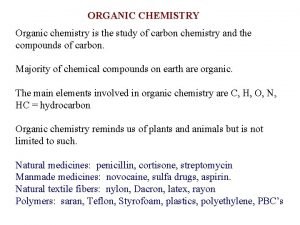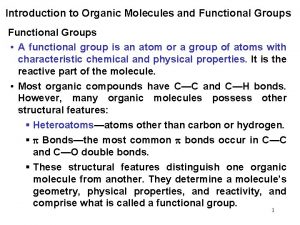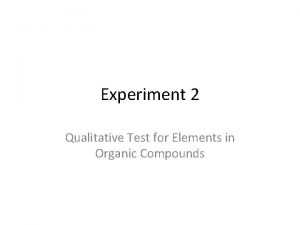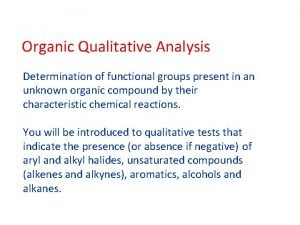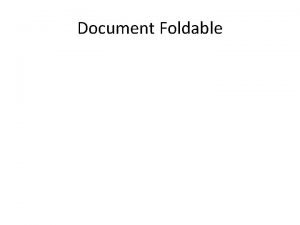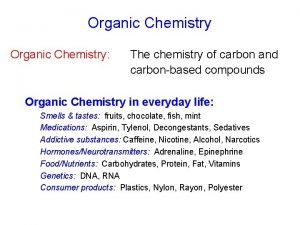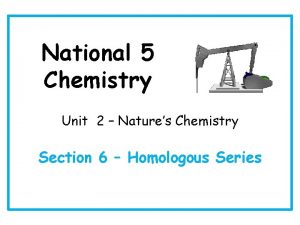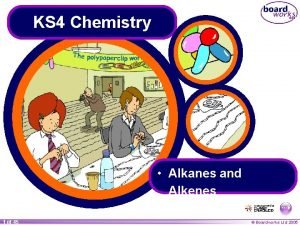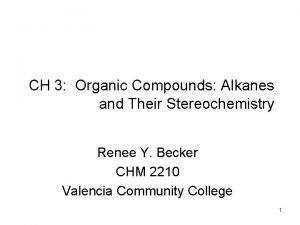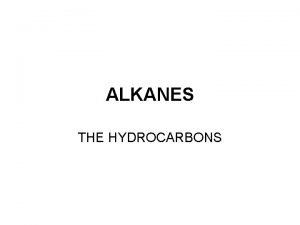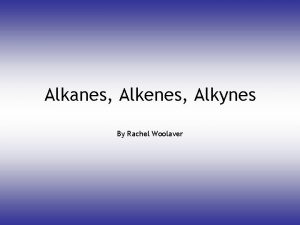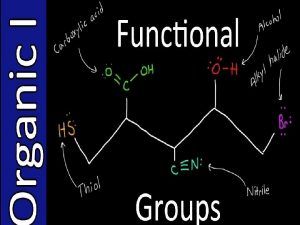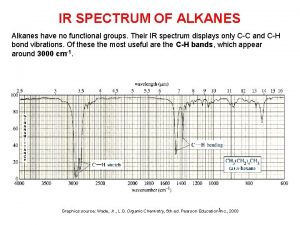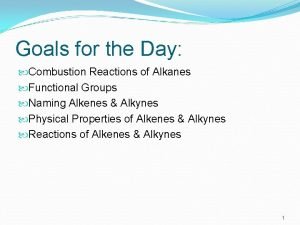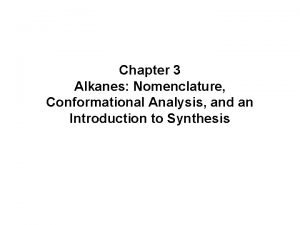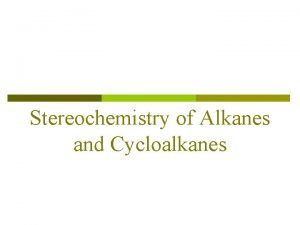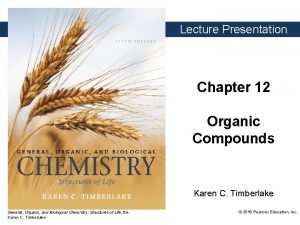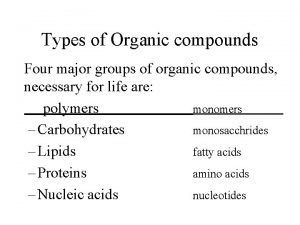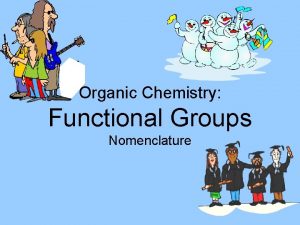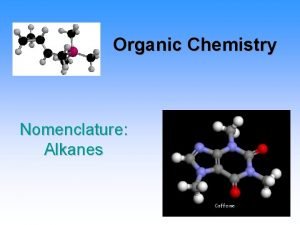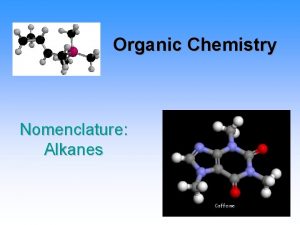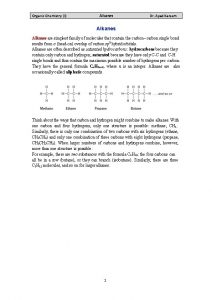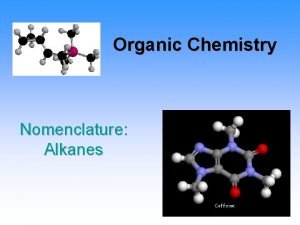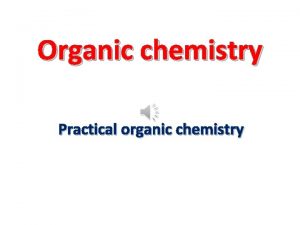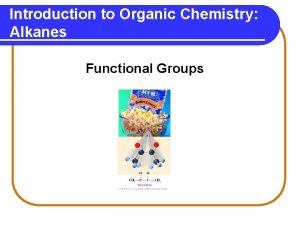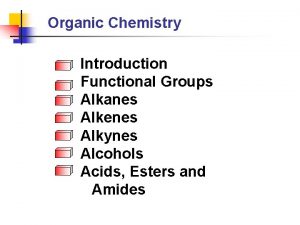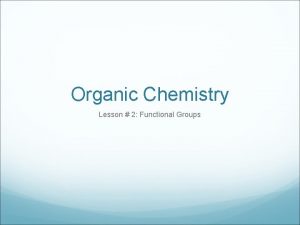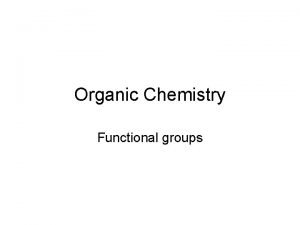Functional Groups QUEST Organic Chemistry Functional Groups Alkanes

































- Slides: 33

Functional Groups QUEST Organic Chemistry

Functional Groups • Alkanes are relatively unreactive. • For an organic molecule to be reactive it needs something additional. • A site of reactivity in an organic molecule is called a functional group.

Functional Group • A functional group could be an atom or a group of atoms within a molecule that is responsible for its characteristic chemical reactions. • C=C double bond is a functional group. • Other functional groups contain elements other than C or H, notably O, N, S and Cl.

alkanes • Only carbon and hydrogen H • All single bonds • Their names end with -ane H H C C H H Ethane H

alkenes H • Only carbon and hydrogen • A carbon to carbon double bond H • Their names end with -ene H C C H Ethene

alkynes • Only carbon and hydrogen • A carbon to carbon triple bond • Their names end with -yne H C Ethyne C H

alcohols • Only one oxygen • Has an O-H group H • Can be classified as 1º/2º/3º according to position of O-H group on carbon skeleton • They are named as alkanol H H C C H H Ethanol O H

H H H C C H H H O H • Primary alcohol H H H O H C C C H H C H 3 • Secondary alcohol • Tertiary alcohol H

aldehydes H • Only one oxygen • Has a C=O group C • C=O group is at the end H of the carbon chain, so is next door to a hydrogen H atom Ethanal • They are named as alkanal O C H

ketones • Only one oxygen • Has a C=O group • C=O group is not at H the end of carbon chain, so is next door to 2 carbons • They are named as alkanone H O H C C C H H Propanone H

carboxylic acids • Has 2 oxygens • Has O-H and C=O groups on the same carbon atom H • This -COOH group has to be at the end of a carbon chain. • They are named as alkanoic acid H C H O C O Ethanoic acid H

esters • Has 2 oxygens • One oxygen is part of a C=O bond, the other is next door, H sandwiched between two carbons. • They are named as Alkyl alkanoate H C H O C O H C H Methyl ethanoate H

ether • Has 1 oxygen • No O-H or C=O group H • The oxygen is sandwiched between two carbon atoms • Their names end with -ether H H C C H H H O C H Ethyl methyl ether H

amines • Contain Nitrogen • Has an –NH 2 group • Can be classified as H 1º/2º/3º according to the number of carbon atoms connected to the N • They are named as alkylamine H H C C N H H H Ethylamine H


amide • Has NH 2 and C=O groups on the same carbon atom • They are named as alkanamide H H C O C H Ethanamide N H H

thiols • Only one sulfur • Has an S-H group • Can be classified as 1º/2º/3º according to position of S-H group on carbon skeleton • They are named as alkane thiol H Also called sulfhydryl group H H C C H H Ethane thiol S H

haloalkanes • Have the general formula R-X where R H is an alkyl group and X is a halogen • They are named as haloalkanes H H C C H H Chloroethane Cl

phenyl • Have the general formula R-C 6 H 5 • but there can be other functional groups attached within the ring • Naming is tricky and involves numbering • A form of arene

What family does it belong to? H H C H

What family does it belong to? H H C H O C H

What family does it belong to? H H H O H C C C H H

What family does it belong to? H H C H H O C H H

What family does it belong to? H H C H O C O H C H H

What family does it belong to? H H H C C H H C S H H

What family does it belong to? H H O H C C C H H H

What family does it belong to? H H H C C H H O C O H

What family does it belong to? H H H C C H H C O H H

Predict Water Solubility As an in-class activity, we will predict molecules’ solubility based on the functional groups present and the # of carbon atoms. Hydrogen bonding increases water solubility.


Solubility Chart First, find all the functional groups. If there is only 1, use the monofunctional compound column. If there is more than 1, use the polyfunctional compound column.

Solubility Chart The number there tells you the maximum # of carbons that can be in that molecule for it to be water soluble. If there is more than 1 functional group, add up the numbers. (Note: phenol is any benzene ring of C 6 H 5 bonded to an -OH)

Examples Note: this is from a Norwegian university, and “atomer” is just a Norwegian plural : )
 Ib organic chemistry
Ib organic chemistry Functional groups organic chemistry table
Functional groups organic chemistry table Functional group
Functional group Ferrox paper
Ferrox paper Inorganic chemistry vs organic chemistry
Inorganic chemistry vs organic chemistry Qualitative analysis of organic functional groups
Qualitative analysis of organic functional groups Which groups led the quest for mexican independence?
Which groups led the quest for mexican independence? Alkanes solubility
Alkanes solubility Isomers of pentane
Isomers of pentane 7 carbon alkene
7 carbon alkene Uses of alkanes
Uses of alkanes Alkanes list
Alkanes list Uses of alkanes
Uses of alkanes Alkanes alkenes alkynes
Alkanes alkenes alkynes Alkanes list
Alkanes list Alcohol ir spectrum
Alcohol ir spectrum Combustion of alkynes
Combustion of alkynes Combustion of alkanes equations
Combustion of alkanes equations Covalently def
Covalently def Alkylation of alkanes
Alkylation of alkanes Viscosity of alkanes
Viscosity of alkanes Cyclopentane uses
Cyclopentane uses Iupac stands for
Iupac stands for Stability of chair and boat conformation
Stability of chair and boat conformation Bromine water test
Bromine water test Organic chemistry iupac name
Organic chemistry iupac name Eth meth prop but pent hex
Eth meth prop but pent hex Applications of alkanes
Applications of alkanes The four major groups of organic compounds are
The four major groups of organic compounds are Cycloalkanes
Cycloalkanes Chemistry of soap making
Chemistry of soap making Ester organic chemistry
Ester organic chemistry Formula of alkene
Formula of alkene Organic chemistry david klein 3rd edition
Organic chemistry david klein 3rd edition

